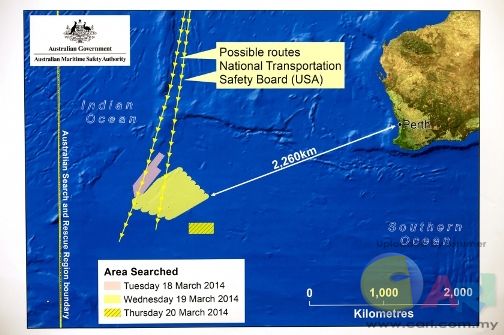 SYDNEY, March 20 — The Australian Maritime Safety Authority (AMSA), the agency leading efforts to find missing Malaysia Airlines flight MH370 in the southern Indian Ocean, has responsibility for a huge sea search area. The discovery of two objects today that may have come from the jet which vanished with 239 people on board on March 8 holds out a possible breakthrough in the investigation. But the government-run AMSA, which along with the Australian Defence Force is responsible for rescue efforts in a vast 52.8 million square kilometres (20.3 million square miles) stretch of land and ocean, said collecting any debris from the water will be difficult. With the assistance of the Australian Air Force, the New Zealand Air Force and the United States Navy the hunt is taking place in a remote area some 2,500 kilometres (1,550 miles) southwest of the western city of Perth. Four aircraft, including a Royal Australian Air Force Orion and a United States Navy P8 Poseidon, have been dispatched to what Australian Defence Minister David Johnston described as “a most isolated part of the world”. “It’s a logistical nightmare. This is a terribly complex logistical operation to identify what we have found via the satellite,” he said in a television interview. The AP-3C Orion is an extremely versatile aircraft used to conduct long-range surveillance missions throughout the Indian and Pacific oceans. The Orions are fitted with radar, infra-red and visual systems which allow crew to see objects at night and in the distance, as well as magnetic anomaly detectors which help in identifying metal. The Poseidon is an even more advanced aircraft described by the US as a long-range anti-submarine warfare, intelligence, surveillance and reconnaissance plane aircraft capable of broad-area maritime operations. AMSA’s Rescue Coordination Centre, which works around the clock and is responsible for the national coordination of both maritime and aviation search and rescues, has experience in difficult conditions. In December, it led the rescue of dozens of passengers and scientists stranded on a Russian ship stuck in ice in blizzards off Antarctica, a crisis which sparked a global operation to pluck them from frozen seas. In May 2013, it coordinated the rescue of Dutch adventurer Ralph Tuijn from the Indian Ocean after his attempt to row from Australia to Africa ended when his boat collided with a massive oil tanker. It has also been instrumental in coordinating the rescue in recent years of hundreds of asylum-seekers whose boats sometimes sink as they try to reach Australia from Indonesia. — AFP
|
ADVERTISEMENT